Types of Ladybugs with Pictures (Including Asian Lady Beetle) – Identification Guide
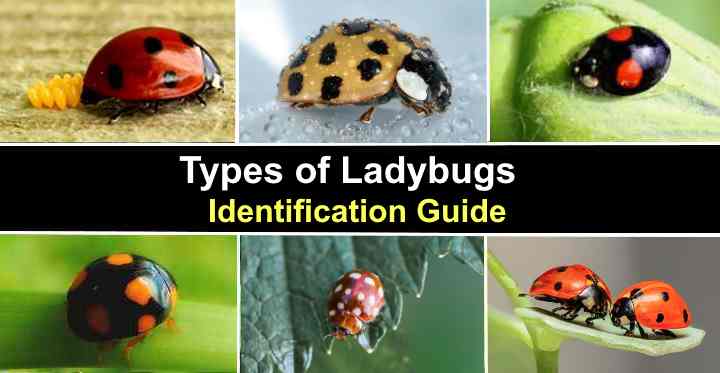
Ladybugs (also called ladybirds and lady beetles) are a type of beetle that usually have a red, oval-shaped body with black spots. The most common color of ladybugs is red but some types of ladybugs have yellow, orange, black, gray, or even pink bodies.
Ladybugs also have flecks on the upper parts of their wings that come in colors such as pink, red, black, yellow or white. Ladybugs can have as many as 13 specs on the upper part of their wings.
Not all ladybugs are red with black dots. Some types of ladybugs (lady beetles) are black with red spots, other ladybugs are white with tiny black markings, whereas others have striped bodies.
Species of ladybugs range from just over 1 mm in length to over 10 mm. Most ladybugs are flying beetles, and this is probably why in many English-speaking countries they are called ladybirds.
There are actually some other bugs or beetles that look like ladybugs but aren’t classified as ladybugs. Some of these fake ladybugs are the clerid beetle, scarlet lily beetle, and Colorado potato beetle.
There are over 6,000 species of ladybugs (ladybirds) worldwide. There are about 150 species of ladybugs in the United States. Some of the common types of ladybugs are Convergent ladybug, California lady beetle, seven-spotted ladybug (C7), 22-spot ladybug, Cardinal ladybird, and pink spotted lady beetle.
Most ladybird species are classified as beneficial flying insects that kill aphids, spider mites, whiteflies, Colorado potato beetles larvae, and other insects that destroy crops.
According to some estimates, about 90% of the many thousands of ladybug species are predators. Ladybugs help to keep down populations of aphids that can destroy crops such as potatoes, grain, and legumes. In fact, organic gardeners buy live ladybugs to use as a natural way to control pests.
Although the majority of ladybug species are beneficial insects and cause no harm, there are some destructive types. One of the destructive ladybugs is the Mexican bean beetle (Epilachna varivestis) that feeds on bean plants. Another type of pest is the Asian lady beetle (Harmonia axyridis) which is in the ladybug classification of Coccinellidae.
In this article, you will learn about the various types of ladybugs. You will also learn how to tell apart ladybugs from the Asian lady beetle which many people consider to be an invasive pest.
Ladybug Life Cycle
The life-cycle of ladybug insects starts as larvae that hatch from eggs. These larvae gorge on aphids which is one of the reasons they are so useful in pest control. Then, the larvae form into a pupa which is usually yellow in color with black markings. After a few days, an adult ladybug beetle emerges and starts feeding on small insects.
Types of Ladybugs (With Pictures) – Identification Guide
The majority of ladybug species are harmless and are good for your garden. Also, you don’t have to worry if you see a native species of ladybird (ladybug) in your home. They don’t bite and they don’t carry disease.
Here are some of the varieties of ladybugs native to North America, Europe, and other countries.
Convergent Ladybug (Hippodamia convergens)
The Convergent ladybug or lady beetle is the most common native species found in North America. Convergent ladybug has a dark orange oval body with 12 black spots of varying sizes on its dome-shaped back. This ladybug species measures between 4 and 7 mm.
Convergent ladybugs are popular to help control aphid populations, which is their main food source, as well as whiteflies and other insects.
California Lady Beetle (Coccinella californica)
The California ladybug is a type of lady beetle that has a red domed back without any black spots. The identifying feature of California ladybug is the black line running down the middle of its back. Its head is mostly black and may have a white spot on either side.
This native Californian lady beetle measures around 5 mm.
C-7 (Seven-Spotted Ladybug) – Coccinella septempunctata
The seven-spotted ladybird is one of the most common native ladybirds you will find in Europe. This is sometimes called C-7 for short.
Despite being common in Europe, the C-7 has been successfully introduced into states in the US. This type of ladybird has 7 spots on its back. There are 6 of similar size on either side of its wing covers and a larger black spot on the middle just behind the pronotum. The C-7 ladybug has a black head similar to the California ladybug.
The seven-spotted ladybird is one of the larger varieties with adult ones measuring up to 10 mm long.
22-Spot Ladybug (Psyllobora vigintiduopunctata)
The 22-spot ladybug is a striking type of ladybird due to its bright yellow color. As its name suggests, there are 22 spots on this small species of lady beetle and it also has 5 spots on its pronotum. The 22-spot ladybug is one of the smaller types of beetles in the Coccinellidae family measuring only 5 mm.
Unlike other aphid-consuming ladybugs, the 22-spot ladybug prefers to eat mildew that grows on shrubs.
Cardinal Ladybird (Vedalia Ladybug) – Rodolia cardinalis
Cardinal ladybug has black body with distinct red markings on its back which means it doesn’t resemble a typical ladybug. This is also a small type of ladybug because adults only grow to between 2 to 4 mm in length.
Native to Australia, the Cardinal ladybug feeds on aphids, small mites, and scale insects. It has been used successfully in Australia and California to control mite infestations in orchards.
Pink Spotted Lady Beetle (Coleomegilla maculata)
The pink spotted lady beetle is also called the twelve-spotted lady beetle. Unlike other ladybugs, the pink spotted lady beetle has a somewhat oblong body rather than an oval one. There are 6 black markings on each pink-colored wing cover.
The pink spotted lady beetle thrives along coastal regions and helps control infestations of Colorado potato beetles.
Hadda Beetle (28-Spotted Potato Ladybug) – Henosepilachna vigintioctopunctata
The common name for hadda beetle has ‘potato’ in it because this ladybug feeds on and damages potato crops. The yellow-orange colored beetle has 14 black markings on each wing cover. The oval body is larger at the head end.
Hadda beetle originates in India and is prevalent in some countries in the Southern Hemisphere.
Two-Spotted Ladybug (Adalia bipunctata)
This red species of lady beetle, the two-spotted ladybug, is called so due to the two black spots on its back. One of the striking features of this type of lady beetle is the 2 large white spots on the pronotum. This makes the beetle look like it has 2 large eyes.
Some species of Adalia bipunctata are known to have more than just two spots. This type of lady beetle is popular in Europe and North America to help control crop pests.
Related article: How to Identify Red and Black Bugs (Including Pictures).
Twenty-Spotted Ladybug (Psyllobora vigintimaculata)
The twenty-spotted ladybug is an unusual-looking beetle due to its cream-colored back and brown markings. Because of its small size of only 2 or 3 mm, it may be very difficult to spot this ladybug.
Orange-Spotted Ladybug (Brachiacantha ursina)
The orange spotted ladybug is an unusual type of ladybug with an orange-spotted body. This is also called the ursine spurleg lady beetle. This shiny black beetle has a pronounced dome-shaped back and an oval body. Each wing cover has a number of bright orange or yellow markings.
Measuring only 3 – 4 mm in size, the orange spotted ladybug may also be hard to find.
Three-Banded Ladybug (Coccinella trifasciata)
Another member of the Coccinella family is the appropriately named three-banded lady beetle. Three black bands wrap around the orange body of this native North American lady beetle. Some say that this beetle looks like a tiger. Being only 4 mm in length, this is another type of small ladybug.
Eye-Spotted Ladybug (Anatis mali)
When you see the eye-spotted ladybug (Anatis mali), it’s not difficult to see how it got its name. Each wing cover has a number of markings that look like tiny eyes. The distinct markings give the large ladybug a unique look. Compared to other ladybugs, this species is of similar size to the 7-spotted ladybird of Northern Europe, 7 – 10 mm.
Fifteen-Spotted Lady Beetle (Anatis labiculata)
The fifteen-spotted ladybug is a very unusual white species of ladybeetle with black markings. Its body has a round, oval shape with markings on either side of its wing covers. This ladybird species measures between 7 and 9 mm. One type of the 15-spotted ladybug species also has a deep purple body.
Twice-Stabbed Ladybug (Chilocorus stigma)
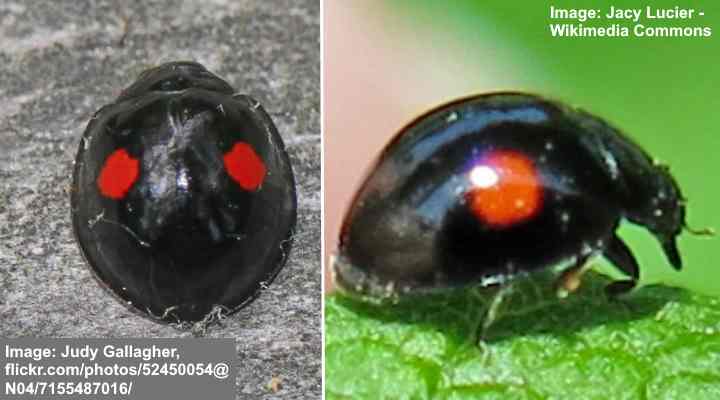
The twice-stabbed ladybug is identified by its black body and two red spots and is common in North America
The twice-stabbed ladybug is a black ladybug with two red spots on its back. The twice-stabbed ladybug measures 0.14” to 0.20” (3 – 5 mm), and is one of the most common red-spotted black beetles in North America.
The black and red beetle is a highly beneficial insect for pest control. It is usually found on plants like roses, sunflowers, marigolds, and pine forests, and feeds on scale insects, mealybugs, and aphids.
Pine Ladybug (Exochomus quadripustulatus)
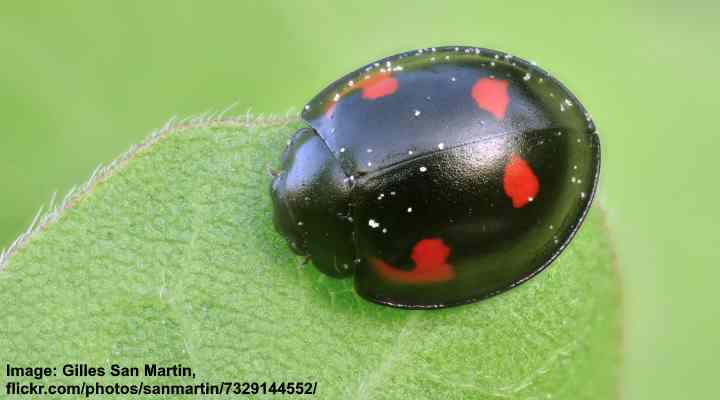
The pine ladybug has distinctive red markings on its shiny black body
The pine ladybug has shiny black wing covers and distinctive comma-shaped red spots, together with small oval or round dots. Some ladybugs may have orange or yellow marks.
Pine ladybugs measure 0.16” to 0.23” (4 – 6 mm) long, and from April to October, you will find them in deciduous and coniferous forests.
Heather Ladybug (Chilocorus bipustulatus)
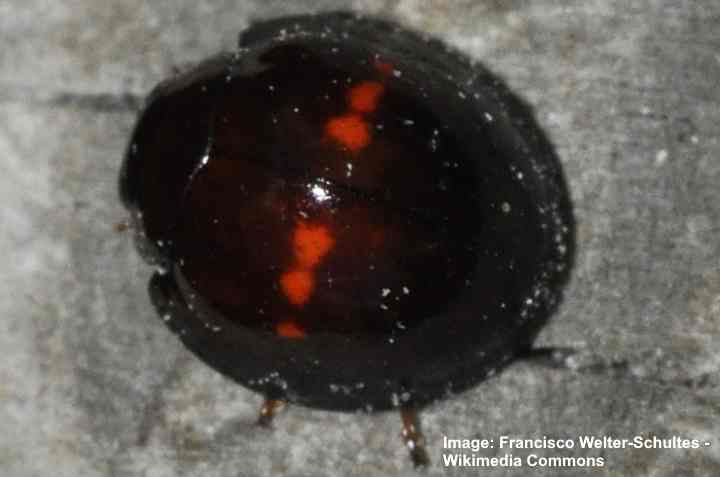
The heather ladybug can be identified by its red spots in a row on a black body
The heather ladybug is a common black beetle with red spots you can find in fruit gardens and pine forests. The small black ladybug’s identifiable features are its shiny black elytra with two or three reddish-orange spots on each side in a straight line.
Heather ladybugs measure 0.12” to 0.20” (3 – 5 mm) long. They are classed as beneficial insects and feed on aphids and scale insects.
Larch Ladybug (Aphidecta obliterata)
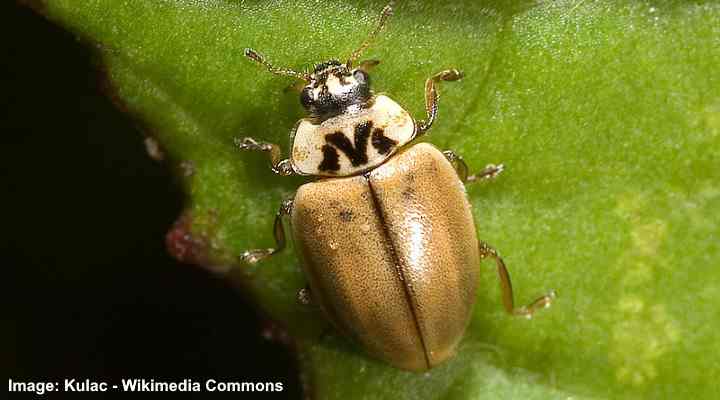
The light brown larch ladybug is common in North America and can be identified by its distinctive M mark on its pronotum
The larch ladybug is one of the most common brown ladybugs you will find on plants in North America. The identifying features of the larch ladybug are tan to brown elytra, a distinctive M mark on its pronotum, and a black head. The brown ladybugs measure 0.14” to 0.20” (3.5 – 5 mm).
The brown larch ladybugs are typically found on pine, spruce, and larch trees. Like most ladybirds, they feed on aphids during spring and summer, when they are most active.
Painted Ladybug (Mulsantina picta)
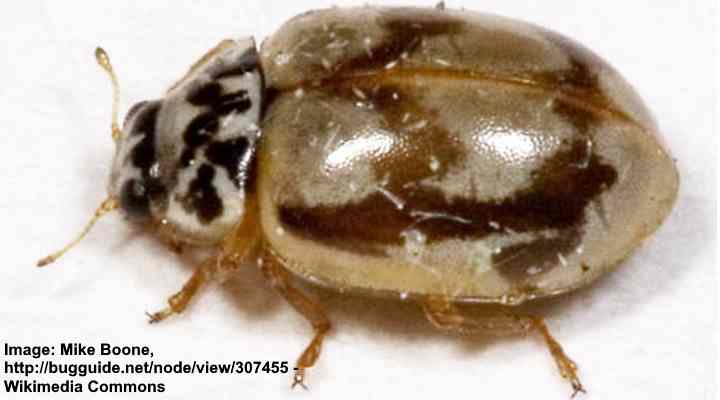
The painted ladybug is identified by its mottled brown and gray patterns and black and white pronotum
The painted ladybug is a common beetle with brown and grayish mottled patterns on its elytra. The patchy brown ladybugs have brown legs, black and white pronotum, and pair of antennae. This tiny brown ladybug measures 0.09” to 0.15” (2.2 – 4 mm) and has several color variations.
Also called pine ladybeetles, the painted ladybug are found in pine forests, feeding on aphids and adelgids.
Rhyzobius chrysomeloides
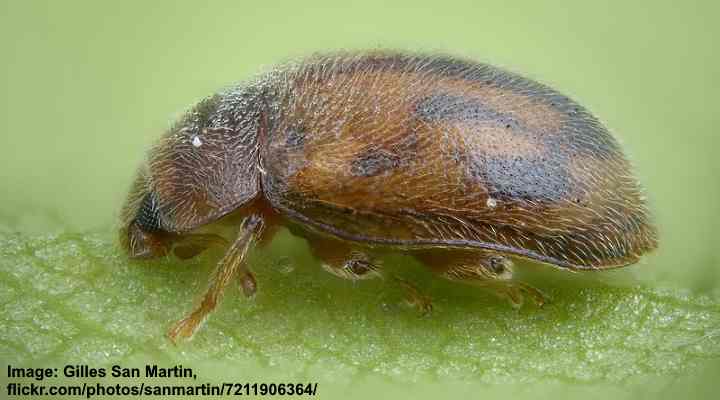
You can recognize Rhyzobius chrysomeloides ladybug by its brown and black patterned body that is covered in fine hairs
The unusual Rhyzobius chrysomeloides is a brown ladybug with dark brown and black elytra covered in fine hairs. The fuzzy brown ladybugs have six legs, two straight antennae, and an oval shape. The head and pronotum have black and brown markings.
Rhyzobius chrysomeloides measures 0.09″ to 0.14″ (2.3 – 3.5 mm) in size. The small brown ladybugs are found on coniferous and deciduous trees, especially if ivy is growing nearby.
Ladybug Classification and Other Facts
Ladybugs belong to a family of small beetles called Coccinellidae, hence a ladybug is actually a type of beetle. Coccinellidae belongs to the super-family of beetles called Cucujoidea. This family includes insects such as fungus beetles, bark beetles, fruit worm beetles as well as lady beetles.
- Ladybug Kingdom: Animalia (All animals)
- Ladybug Phylum: Arthropoda (Invertebrates)
- Ladybug Class: Insecta (Insects)
- Ladybug Order: Coleoptera (Beetles)
- Ladybug Super Family: Cucujoidea (Super Family of Beetles)
- Ladybug Family: Coccinellidae (Lady Beetles)
The lower classification of ladybirds depends on their size, color, number of spots, and habitat. For example, Coccinella septempunctata is a red-colored variety of lady beetle with 7 spots and is the most common one in Europe. Hippodamia convergens is a type of lady beetle that belongs to the Coccinellidae family and is the most common ladybug species in North America.
What Ladybugs Eat
The usefulness of ladybirds is due to the fact that they gorge on almost anything. So, what do ladybugs eat apart from aphids? Researchers have found that different types of ladybugs eat different things.
Here are a few examples of the types of food ladybugs eat:
- Most types of ladybugs eat mealybugs, scale insects, and, of course, aphids.
- Depending on their food source, ladybugs may also drink water, honeydew, or feed on the nectar from flowers.
- Ladybugs that belong to the lower classification of Coccinellidae called ‘Halyziini’ feed on fungal growths on plants.
- The tiny Stethorus utilis species of lady beetle eats mites and other small bugs.
Bugs that Look Like Ladybugs
There are a few bugs or beetles that look like ladybugs which aren’t classified as ladybugs (Coccinellidae). These fake ladybugs can easily be mistaken for true ladybugs as they look similar to them. These types of beetles include the clerid beetle, scarlet lily beetle, and Colorado potato beetle.

These bugs are types of beetles that look like ladybugs but are actually fake ladybugs. From left to right: the Clerid beetle, Scarlet lily beetle, and Colorado potato beetle
One type of bug that looks like a ladybug and is actually from the same Coccinellidae family, is the Asian lady beetle. Even though the Asian lady beetle is similar to native ladybugs, they act completely different. This is why many people consider them to be an invasive pest.
To know how to identify the difference between these ladybug impostors, it’s important to know more about them.
Asian Lady Beetle (Japanese Ladybug)
The multicolored Asian beetle was imported into the US and other countries to control the number of crop-destroying pests. However, the Asian beetle itself has become a nuisance for many people. The Asian lady beetle is now becoming a pest in many countries.
Asian lady beetles look similar to native ladybugs but they bite and can cause allergic skin reactions.
In late fall and early winter, Asian ladybugs start flying to warmer climates. Large numbers can swarm and invade homes. The biting ladybugs can also cause an irritating bite on exposed skin. Unlike native ladybugs, Asian ladybugs leave an odorous slimy fluid when squashed. (3)
The Asian Lady Beetle (Harmonia axyridis) is in the Coccinellidae family and the Coleoptera order. Other names for this invasive pest include the Japanese ladybug, Halloween ladybeetle, harlequin, or multicolored Asian beetle.
Scientists have identified that species of Asian lady beetles come in many colors. Asian ladybugs are winged insects that are between 5 and 8 mm in length with oval body. Many Asian lady beetles have red body with black spotted markings. They can also be orange color or cream color and may or may not have markings. (4)
Being classified as a true member of the lady beetle family (Coccinellidae), Asian beetles have a similar life-cycle. After the eggs hatch, larvae feed on soft plant food. They then molt their skin 4 times before becoming a pupa. After that, they emerge from this pupa state as adult Asian lady beetles.
The best way to prevent swarming Asian ladybugs invading your home is to caulk crevices around windows, doors, and pipes. This is essential in preventing further infestations as the “bugs” have been known to return year after year to the same place.
The Asian Lady Beetle is a Ladybug Imposter that Bites
If you have been bitten by a ladybug, chances are that this was an Asian lady beetle and not the Convergent ladybug or the 7-spot ladybird.
What does an Asian lady beetle bite feel like? Fortunately, these flying ladybugs don’t have a nasty bite. Scientists say that the bite feels like a pinprick and only rarely has complications. (5)
Unlike harmless native ladybugs, the Asian type of ladybug can leave behind stinky yellow secretion. For some people, this can cause allergic skin reactions or asthma.
Ladybug vs. Asian Beetle (Asian Lady Beetle)
Telling the difference between native ladybugs and biting Asian lady beetles can be challenging. Both look similar and are of similar size. However, there are some tell-tale signs that allow you to tell them apart such as the markings on their head and the bite.
Bite – One of the main differences between ladybug and Asian beetle is the bite. Ladybugs native to North America and Europe are not biting beetles. As already mentioned, Asian ladybugs can pinch the skin.
Swarming nature – The other the difference between ladybug and Asian lady beetle is the swarming nature of Asian beetles. If you see a lonely ladybird, then it is probably a native ladybug species. Unlike native ladybugs, Asian beetles swarm in large numbers and quickly cover windows. This is because, in the fall, swarming beetles look for warm surfaces.
Head marking – One other difference between ladybugs and Asian ones is the markings on their head. From above, Asian lady beetles have a white “M” shaped spot where their head meets the body on their pronotum. This is the part of their body between their head and body, and is usually black.
Before you try to get rid of an Asian beetle, be aware of their “reflex bleeding.” When the red flying pests feel threatened, they excrete a staining acrid yellow substance. Harmless ladybugs don’t do this.
Due to their more aggressive nature, the Asian ladybugs can harm dogs. One report mentions Asian beetles that got embedded in the mucosa of the dog’s mouth (the soft tissue that lines the mouth). The beetles secreted a toxic chemical substance that caused burning to the dog’s mouth. (5)
It is said that once the beetle is stuck into the dog’s mucosa, it is hard for the dog to get rid of it, and usually manual removal is required. Some vets have reported a few cases where dogs ingested Asian beetles and developed stomach upset such as vomiting and diarrhea.
How to Get Rid of Asian Lady Beetles
If you have identified Asian lady beetles in your home, the best way to eradicate them is with a vacuum cleaner. This prevents crushing them and risks staining fabrics or having to deal with the disgusting odor they leave behind.
Once you get rid of them, you need to seal up any cracks or crevices where they could enter your home. Asian ladybugs leave behind pheromones that will continue to attract these flying pests to your home year after year.
Related articles:
















